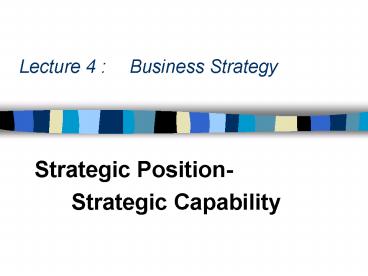Lecture 4 : Business Strategy PowerPoint PPT Presentation
1 / 19
Title: Lecture 4 : Business Strategy
1
Lecture 4 Business Strategy
- Strategic Position-
- Strategic Capability
2
Learning Outcomes
- importance of knowledge and knowledge management
- meaning and importance of critical success
factors - strategic importance of resources and concept of
unique resources - importance and meaning of core competences
- factors that create value for money in products
and services - importance of performing better than competitors/
concept of benchmarking - why some strategies are more difficult to imitate
than others - how key issues can be summarised (SWOT)
3
Strategic Capability (SC)
- underpinned by the resources available to firm
- resources can be grouped into
- physical resources (machines, buildings)
- human resources (skills)
- financial resources (capital, cash)
- intellectual capital (intangibles, brands,
relationships with partners) - (Johnson and Scholes, 2002)
4
Strategic Importance of Resources
- threshold resources
- basic resources needed to enter and stay in a
market - change/rise with time as a result of activities
of competitors and new entrants - unique resources
- resources which critically underpin competitive
advantage - (Johnson and Scholes, 2002)
5
Competences /Core Competences
- activities or processes that critically underpin
an organisations competitive advantage... - need to view them through eyes of customer
- benchmarking can help in understanding
performance standards (e.g. constitution of good
or poor performance) - must be robust (difficult to imitate)
- (Johnson and Scholes, 2002)
6
Where Core Competences Reside
- Managers can find it difficult to establish where
they reside - Value chain concept is useful tool
- Value chain describes activities within and
around a firm which together create a product or
service - (Johnson and Scholes, 2002)
7
Value Chain
- A value chain is a linked set of value-creating
activities beginning with basic raw materials
coming from suppliers, moving on to a series of
value-added activities involved in producing and
marketing a product or service, and ending with
distributors getting the final goods into the
hands of the ultimate consumer - (Wheelen and Hunger, 2000, p. 84)
8
Value Chain (Porter, 1985)
- Primary Activities
- inbound logistics
- operations
- outbound logistics
- marketing/sales
- service
- Support Activities
- Infrastructure
- Human Resource Management
- Technology Development
- Procurement
9
Typical Value Chain for a Manufactured Product
Fabrication
(Source Galbraith, 1991, p. 316)
10
Distinctive Competences
- When a firm is able to perform a particular
value-adding activity in ways that are superior
to that of its competitors, then this activity
forms the basis for the firms distinctive
competence (DC). - A DC allows the firm to do things in ways that
distinguish it from competitors and defines how
firms are likely to form their strategies. - (Pitts and Lei, 1996, p. 68)
11
Delivering Value for Money
- Cost efficiency a measure of the level of
resources needed to create a given level of value
(e.g. economies of scale, experience, supply
costs, product/process design) - Effectiveness ability to meet customer
requirements on product features at a given cost - (Johnson and Scholes, 2002)
12
Performing Better than Competitors
- Historical comparison - tracking previous
performance to identify any significant changes - Industry norms - compare performance of
organisation in same industry or sector against a
set of agreed performance indicators - Best-in-class benchmarking- compare firms
performance against best-in-class performance - (Johnson and Scholes, 2002)
13
Importance of Knowledge
- Knowledge is awareness, consciousness or
familiarity gained by experience or learning - In complex and dynamic environment, firms able to
create and integrate knowledge better than
competitors are likely to gain advantage - (Johnson and Scholes, 2002)
14
Resource-Based Approach
- VRIO framework (key resources)
- Value (Does it provide competitive advantage?)
- Rareness (Do other competitors possess it?)
- Imitability (Is it costly for others to imitate?)
- Organisation (Is the firm organised to exploit
the resource?) - (Wheelen and Hunger, 2000, p. 82)
15
Sources of Competitive Advantage
- resources difficult to imitate competitive
advantages - 3 possible ways to sustain competitive advantage
- advantages residing in the organisation
- advantages stemming from specific functional
areas - advantages based on relationships with external
entities - (Wensley, 1987, p. 34)
16
Sources of Competitive Advantage
- A firm builds a competitive advantage when
- it applies its strengths in ways to perform some
value-adding activity that other firms cannot do
as well. - Competitive advantage comes from the ability
- to perform activities more cheaply than rivals
- or more effectively than rivals
- (Pitts and Lei, 1996, p. 68)
17
Strengths and Weaknesses
- A SWOT analysis summarises the key issues from
the business environment and the strategic
capability of an organisation that are most
likely to impact on strategy development - (Johnson and Scholes, 2002, p. 183)
18
Summary
- SC is about ability to provide products/services
with features that are valued by customers.
Competitive advantage will be achieved by firms
able to do this better than competitors in ways
which are difficult to imitate. - Understanding what customers value or might value
in future is important (including threshold and
critical success factors) - SC starts with resources
- Resources need to be deployed into activities to
create competences
19
- Core competences underpin competitive advantage -
fundamentally must contribute to value for money
in eyes of customer must be performed better
than competitors must be relatively difficult to
imitate - Delivering value for money requires management of
cost and product features - Value for money can stem from good links in value
chain - Customer value changes over time
- Benchmark performance standards
- Competences might be robust as a result of
rarity, complexity or cultural issues

